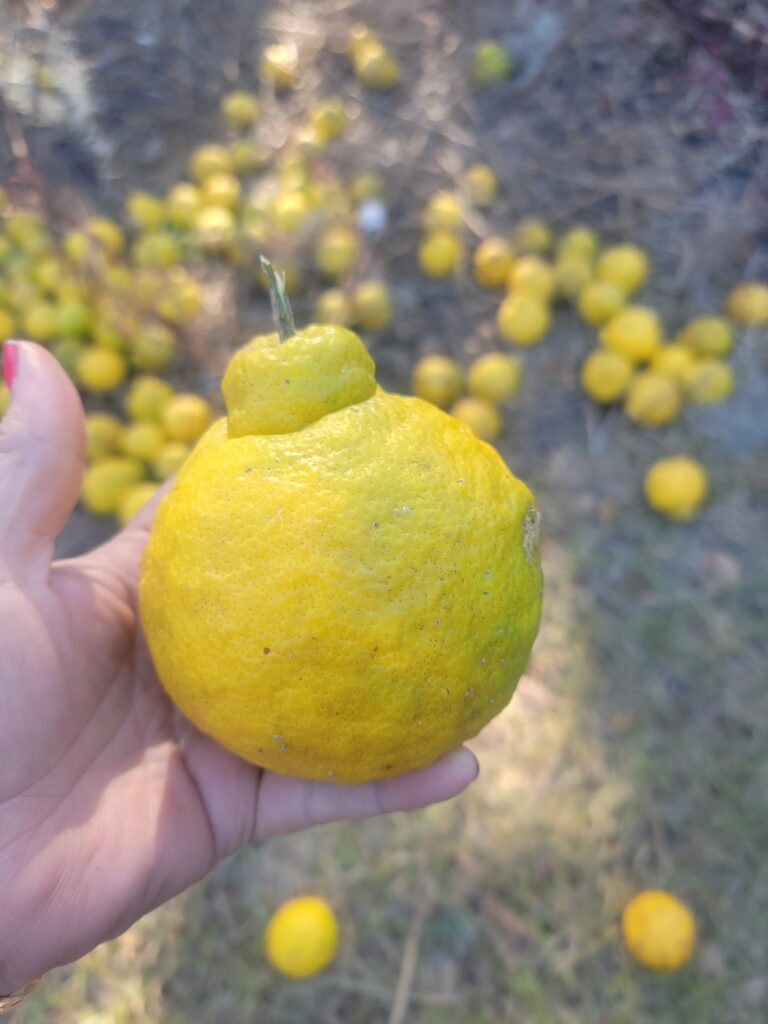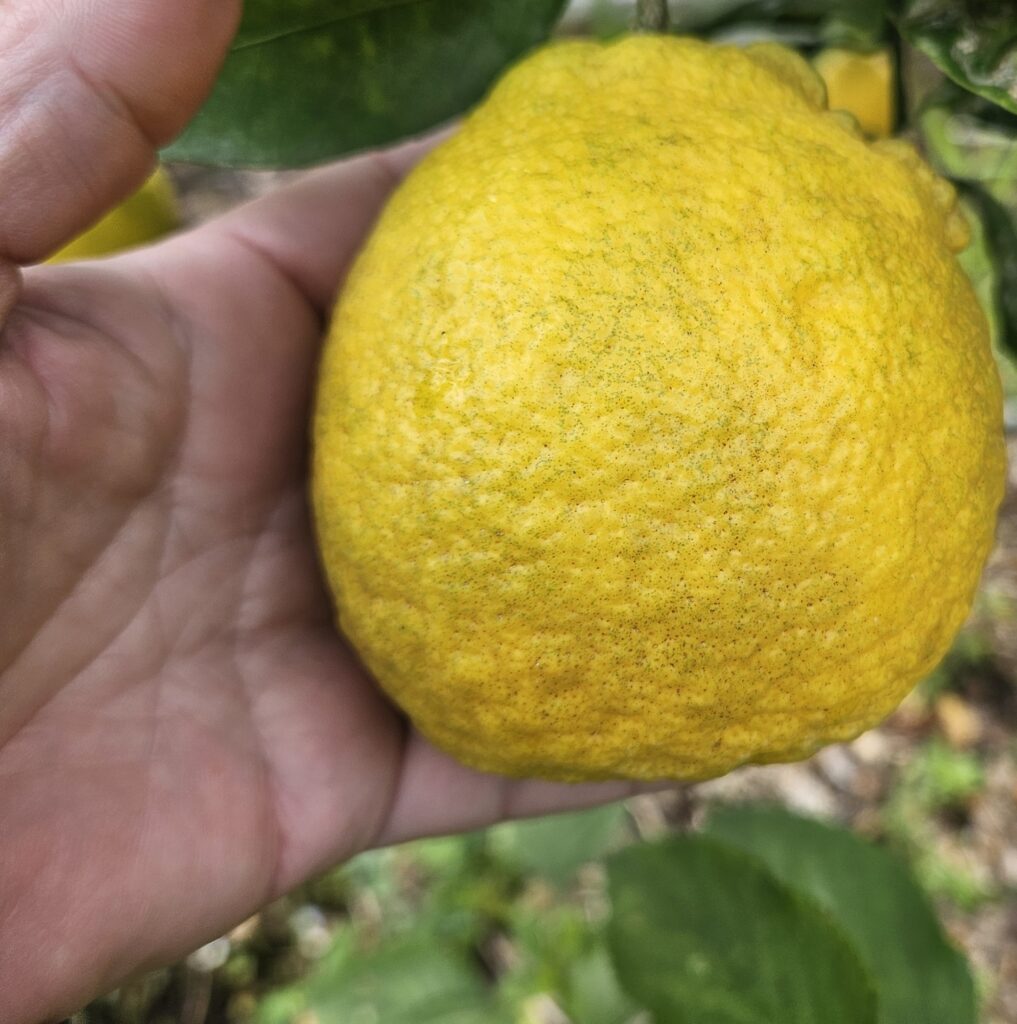Growing Sanbokan | Sambo | Sumo |Sambo Sweet Lemons
in Northeast Florida Landscapes (Citrus paradsii)
Origin of Sanbokan | Sambo Lemons For Northeast Florida :

Sanbokan is a rare Japanese lemon fruit cultivar that is of unknown parentage and thought to have been a natural cross with a grapefruit. Although it has a deep history it was first described in 1848 it was introduced to the US in 1978 from Chiefland Budwood Facility as a cold hardy lemon cultivar and has many names (all listed above) that it can be found growing under. No matter what name you decide to stick with, this lemon is delicious and unique. It has a really high sugar content and the result is extremely sweet with a hint of lemony sourness, almost like eating a very sweet lemonade drink fresh from a tree.
Winter Temperature Tolerance For Sanbokan | Sambo Lemon Trees:
Lemons are the most cold sensitive of Citrus fruit but can be planted and maintained easily in our area of Northeast Florida in zones 9-11. Sanbokan Lemons are notable for their cold tolerance and are an excellent selection for our area.
Sun Exposure for the Sanbokan | Sambo Lemon Tree in Northeast Florida:
Plant Sanbokan trees where they will receive full sun in the Jacksonville and St. Augustine area landscapes.
Foliage of the Sanbokan Trees:
Sanbokan lemon trees have slightly darker green foliage than other lemon cultivars and remain evergreen throughout the winter season.
Soil Preference for the Sanbokan |Sambo Lemon Tree:
It is no longer a recommended practice to amend the soil in the planting hole on Citrus trees in good soil according to the University of Florida’s Institute of Food and Agricultural Sciences. However, probably due to the simple fact that old habits die hard, one UFIFAS citrus publication cautions, if you are going to amend your soil be sure to use a 50-50 ratio. In other words, use equal parts soil amendment and native soil (that is the soil you dug out of the hole before placing the tree in it), and mix the amended soil together with the native soil before back filling the hole around the tree.
Planting and Mulching Tips For Sanbokan |Sambo Lemon Trees in the Jacksonville or St. Augustine area landscape:
NOTE: THIS IS IMPORTANT, I am going to say this three times in three different ways and hope at least one of these makes some sense!
-Be sure to plant into well draining soils, and keep the soil level of the dirt in the container above the soil level of the ground by 1-2 inches when you are finished planting.
-The soil that your tree was growing in should be slightly higher or level with the ground. Never plant the tree where the root ball of the tree once planted into the ground is lower than the grade of the yard.
– Never bury the top of the root system that the tree was growing in. The soil in the top of the pot should be exposed to the air after planting, not buried by soil in any way.
Caution: Do not build berms around Citrus to hold water, as is recommended for pretty much all other trees. Leave a 12 inch diameter area around Citrus tree trunks with no mulch, do not put mulch up to the trunk of the tree on Citrus Root rot can develop quickly and good drainage is essential to a healthy tree.
Remove the grass and weeds growing under the foliage of any Citrus tree in Northeast Florida about a foot beyond where the foliage stops. Don’t allow grass and weeds to regrow under your Florida Citrus.
When planting in areas with a high water table, consider planting your Citrus into a raised berm a few feet high and 6or more ft wide. This will keep your Citrus roots up out of the water soaked ground during periods of heavy rain.

Wow, that was a lot of “don`ts”! Here’s one last one. Don’t worry, it really isn’t as hard as it seems, once you get them going Citrus trees just keep on growing! Also, Ill leave you with a “DO” and its an important one as well
“DO” mulch your citrus tree with any fallen Oakleaves you can find, beg some off a neighbor if you must. UFIFAS has recommended this practice for helping to combat Citrus greening. It seems the tannin in the Oak leaves may in fact keep the Psyliids responsible for the spread of the disease at bay, or at least help deter them from your tree!
Size of the Sanbokan |Sambo Lemon Tree When Mature:
The mature size on a Sanbokan | Sambo lemon tree is around 10-15ft tall and 10-15ft wide when left untrimmed.
Pruning and Growth Habits of Sanbokan | Sambo Lemon Trees for the Northeast Florida Landscape:
Sanbokan | Sambo Lemon trees are short and wide with dense branching structures full of foliage.
Pruning may be needed on occasion to remove suckers that sprout up from the trunk, or to remove dead wood that can cause problems when left on the tree.
When purchasing trees from an S & J Nursery container less than a 30 gallon pot size, pruning may be needed to shape the young trees into a desirable framework, and light pruning each year to develop the lemon trees rounded or mushroom shaped canopy.
As the tree matures it should be shaped by selecting 3-5 main branches, well spaced along the trunk for fruiting production. Remove branches with narrow angles, and sub branches that are crossing or rubbing on other branches.
Pruning Tip for Citrus Trees: Light but frequent pruning has a tendency to relocate fruit from being produced mainly on branch tips to inside the canopy of the citrus tree. This can help increase the trees yield and keep the end heavy branches from breaking during overly productive years on some Citrus species.
Blooms and Fruit of the Sanbokan | Sambo Lemon Trees for Northeast Florida Landscape:
There may be nothing quite like a citrus tree in full bloom. The smell is magnificent! Mature citrus trees are said to be able to produce up to 100,000 blooms in a single year! The Sambokan lemon will bloom in the springtime with large white heavily scented blossoms that smell absolutely amazing. There really is nothing quite like citrus blossoms perfuming the landscape!
Sanbokan | Sambo lemon trees are self pollinating, so there is no need for a second tree to pollinate your lemon tree in order for it to produce fruit.
The fruit is large, heavily seeded and has a thick skin that peels away from the flesh of the lemon easily much like a tangerine does. Sometimes loosening before I even get them off my tree. Harvest From November to March! In Northeast Florida some years my Sanbokan lemons are still green when they are already ripe and ready to eat. They will turn yellow if you pick them from the tree and leave them sitting a few days but they taste the same either way!
Water Requirements of the Sanbokan | Sambo Lemon in the Jacksonville and St. Augustine area Landscape:
Newly planted citrus trees require watering every other day for the first month and twice a week for the first few months, or in sandy soils when the top two inches of soil is dry to the touch. Take care to make sure that newly planted citrus trees receive water at least once a week for the first 2 years after being planted, skipping watering altogether once the local rain season is here.
Mature citrus trees need little to no supplemental irrigation and are more often damaged by over watering than under watering.
When citrus trees need supplemental irrigation, make sure to irrigate the soil only and not the trunk or foliage, this is best done by hand with a hose.
Fertilizing Your Sanbokan | Sambo Lemon Tree for Northeast Florida, Jacksonville and St. Augustine area Gardens:
Lemon trees tend to be a bit demanding on the fertilizing side of the equation. But Sanbokan | Sambo lemon trees produce fruit heavily and reward you bountifully for all of your your efforts!
A good quality fertilizer specifically formulated for citrus trees should be used. Fertilize in spring, again in summer and, skip the fall application in Northeast Florida, and then again in January. Spread your fertilizer out into the circle of non grass area under the Canopy of your citrus tree.
Other Great Citrus Trees available at S & J Nursery for the Northeast Florida,
Jacksonville | St. Augustine Area Gardens
Bearss Lemon

